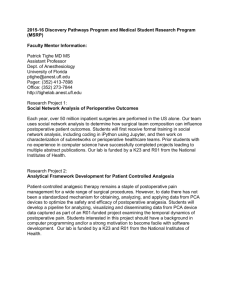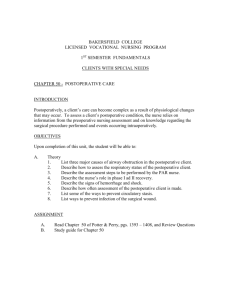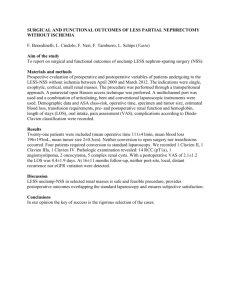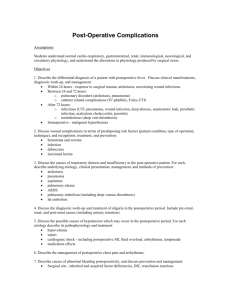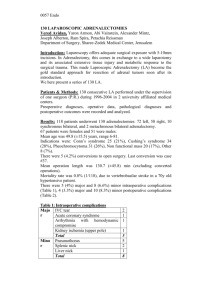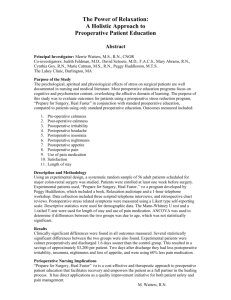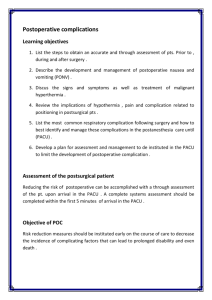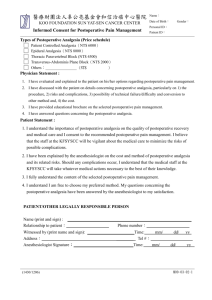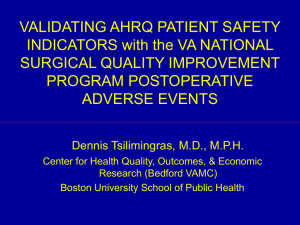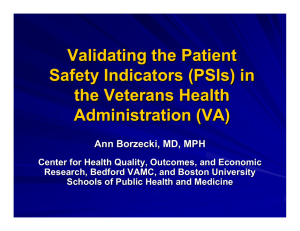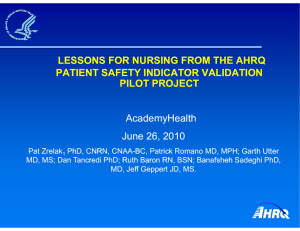d3-examples-effectivepsiimprovement
advertisement
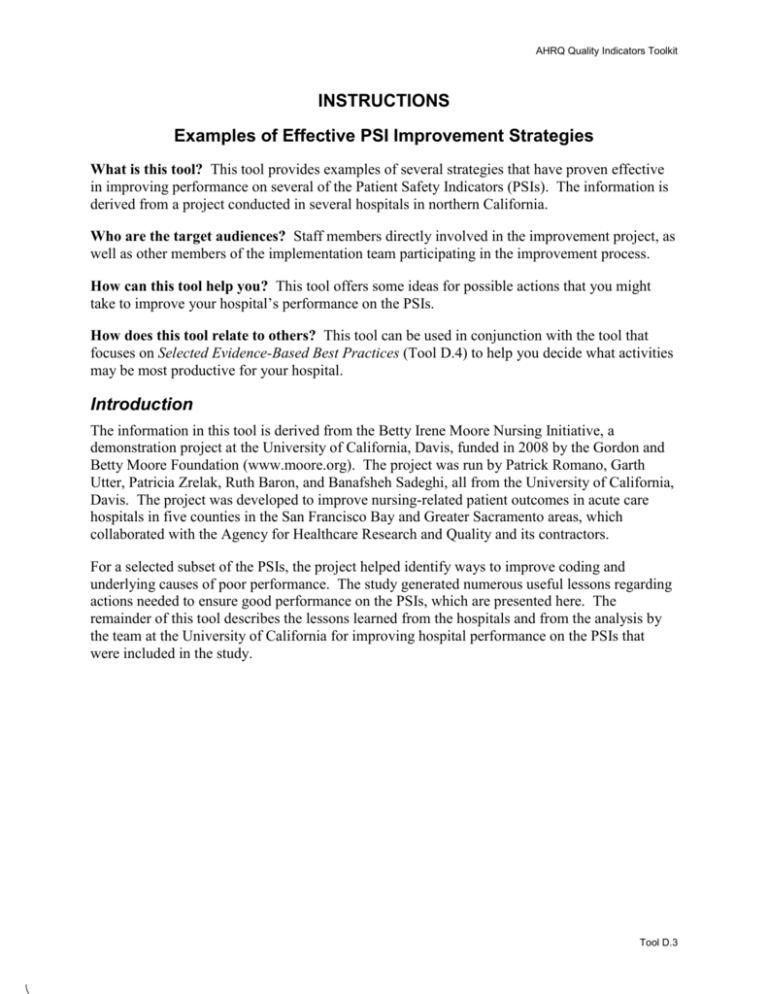
AHRQ Quality Indicators Toolkit INSTRUCTIONS Examples of Effective PSI Improvement Strategies What is this tool? This tool provides examples of several strategies that have proven effective in improving performance on several of the Patient Safety Indicators (PSIs). The information is derived from a project conducted in several hospitals in northern California. Who are the target audiences? Staff members directly involved in the improvement project, as well as other members of the implementation team participating in the improvement process. How can this tool help you? This tool offers some ideas for possible actions that you might take to improve your hospital’s performance on the PSIs. How does this tool relate to others? This tool can be used in conjunction with the tool that focuses on Selected Evidence-Based Best Practices (Tool D.4) to help you decide what activities may be most productive for your hospital. Introduction The information in this tool is derived from the Betty Irene Moore Nursing Initiative, a demonstration project at the University of California, Davis, funded in 2008 by the Gordon and Betty Moore Foundation (www.moore.org). The project was run by Patrick Romano, Garth Utter, Patricia Zrelak, Ruth Baron, and Banafsheh Sadeghi, all from the University of California, Davis. The project was developed to improve nursing-related patient outcomes in acute care hospitals in five counties in the San Francisco Bay and Greater Sacramento areas, which collaborated with the Agency for Healthcare Research and Quality and its contractors. For a selected subset of the PSIs, the project helped identify ways to improve coding and underlying causes of poor performance. The study generated numerous useful lessons regarding actions needed to ensure good performance on the PSIs, which are presented here. The remainder of this tool describes the lessons learned from the hospitals and from the analysis by the team at the University of California for improving hospital performance on the PSIs that were included in the study. Tool D.3 AHRQ Quality Indicators Toolkit PSI 6: Iatrogenic pneumothorax Watch for inadequate documentation, such as “rule out” pneumothorax without alternative diagnosis established after a study (chest x ray or CT scan). Increase the use of bedside ultrasound guidance during placement of central venous catheters, especially in the operating room, intensive care unit, and emergency department. This is proven to reduce iatrogenic injury during internal jugular placement. Limit the use of the subclavian approach to patient for whom access to the neck is limited (e.g., trauma/code resuscitations), patients with suspected neck injuries, and those lacking other available sites. PSI 7: Central venous catheter-related bloodstream infection Identify tunneled catheters that are infected at admission and code as present on admission (POA). Minimize the use of femoral venous catheters, which are associated with higher rates of infection. Remove catheters at the earliest opportunity that is consistent with patient safety. PSI 9: Postoperative hemorrhage/hematoma The logic of the indicator may capture both intraoperative and postoperative hemorrhage, especially if bleeding persists after surgery. The impact of true positive cases was significant, with most cases returning to the operating room, but opportunities for improvement are unclear. PSI 10: Postoperative physiologic/metabolic derangement Postoperative renal failure requiring dialysis Recognize renal failure as early as possible. Evaluate the use of nephrotoxic medications, especially nonsteroidal anti-inflammatories (NSAIDs), in postoperative settings. Review the documentation and use of ionic contrast. Postoperative diabetic complications Monitor and manage to achieve tighter postoperative blood sugar control in Type I diabetes mellitus. Consider insulin drips instead of implanted pumps or SQ in the immediate postoperative period. PSI 11: Postoperative respiratory failure Avoid using ICD-9 procedure code 96.04 when intubation is an expected part of a procedure. Improve documentation of the reasons for reintubation or prolonged ventilation. Three clinical issues that were identified during the project potentially warrant further attention. There were two cases of oversedation leading to respiratory complications; some patients likely could have been extubated earlier, which would not have counted as respiratory failure; and 2 Tool D.3 AHRQ Quality Indicators Toolkit several cases had massive blood loss, which seemed to precipitate postoperative respiratory issues. PSI 12: Postoperative deep vein thrombosis/pulmonary embolism Watch for inadequate documentation, such as “rule out” deep vein thrombosis or pulmonary embolism without alternative diagnosis established after study. Use new International Classification of Diseases (ICD)-9 codes to capture chronic venous thromboembolism. Consider more timely use, beginning on day 0, of pharmacologic prophylaxis. This may be beneficial, especially for perioperative patients at intermediate risk and without contraindications. Also consider whether mechanical prophylaxis alone is adequate. Monitor physician ordering practices of deep vein thrombosis prophylaxis; educate and reinforce order sets in electronic health records. Review deep vein thrombosis/pulmonary embolism cases for adherence to deep vein prophylaxis guidelines on a monthly basis. Examine and present results from monitoring data to providers. Educate physicians about deep vein thrombosis guidelines and order sets. PSI 15: Accidental puncture or laceration There is occasional overcoding of intraoperative bleeding and other routine events as accidental puncture or laceration. Most true positive cases had extenuating circumstances. Some were probably preventable with earlier conversion of laparoscopic to open abdominopelvic surgery, or with the use of Doppler ultrasound to identify structures. Hospitals with inexperienced operators performing technically difficult procedures may experience similar patterns of events. References Morton JM. Metric magic: creating synergy between indicators, priorities, and mandates. NPSF Patient Safety Congress, Orlando, Florida, May 18, 2010. Romano PS. Lessons learned from PSI validation and demonstration projects.” University HealthSystem Consortium Webinar, May 6, 2010. 3 Tool D.3
